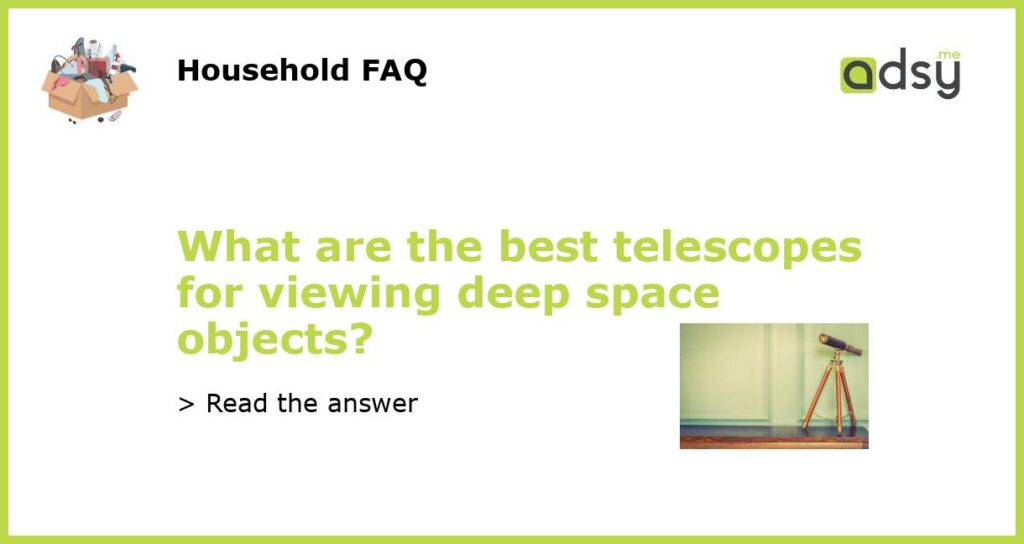Understanding Deep Space Objects
Before delving into the best telescopes for viewing deep space objects, it is important to understand what these objects are. Deep space objects (DSOs) refer to astronomical objects that are located outside our solar system. This includes galaxies, nebulae, star clusters, and other celestial bodies. Viewing these objects can be an awe-inspiring experience, offering a glimpse into the vastness and beauty of the universe.
Factors to Consider in Choosing a Telescope
When searching for the best telescope for viewing deep space objects, there are several key factors to consider. These include aperture size, focal length, mount stability, and portability. The aperture size determines the telescope’s ability to gather light, with a larger aperture allowing for clearer and brighter images. Focal length, on the other hand, affects the magnification and field of view of the telescope.
Mount stability is crucial for long-exposure photography and steady viewing, as it reduces image shake. Lastly, portability is an important consideration for those who want to travel with their telescope or have limited space for storage.
Top Telescopes for Deep Space Viewing
1. Celestron NexStar 8SE: With an 8-inch aperture and a focal length of 2032mm, the Celestron NexStar 8SE is a popular choice for deep space viewing. It comes with a computerized GoTo mount, making it easy to locate and track celestial objects. The OTA (optical tube assembly) is also compatible with various accessories, allowing for further customization of your viewing experience.
2. Orion SkyQuest XT10 Plus: Ideal for those looking for a more budget-friendly option, the Orion SkyQuest XT10 Plus offers a 10-inch aperture and a focal length of 1200mm. This Dobsonian-style telescope provides excellent light-gathering abilities and comes with a stable base, making it easy to use and set up.
3. Meade LX200-ACF: The Meade LX200-ACF is a high-end option for serious astronomers. With an aperture ranging from 8 to 16 inches, it provides outstanding image quality and detail. The telescope features a computerized GoTo mount, allowing for precise tracking of deep space objects.
4. Sky-Watcher ProED 100mm: For those interested in astrophotography, the Sky-Watcher ProED 100mm is an excellent choice. This apochromatic refractor telescope offers a wide field of view and high contrast images. Its compact size and portability make it suitable for travel as well.
5. Orion 8974 SkyQuest XT8 Plus: Another budget-friendly option, the Orion 8974 SkyQuest XT8 Plus offers an 8-inch aperture and a focal length of 1200mm. It provides great views of deep space objects and comes with accessories such as a finder scope and two eyepieces.
Additional Tips for Deep Space Viewing
Investing in a good telescope is just the first step towards exploring deep space objects. Here are some additional tips to enhance your viewing experience:
– Find a suitable viewing location: Light pollution can greatly impact your ability to view deep space objects. Choose a location away from city lights to minimize interference.
– Allow your eyes to adapt: When observing faint objects, it is important to give your eyes time to adjust to the darkness. Avoid looking at bright lights or using your phone during this process.
– Use appropriate eyepieces: Different eyepieces offer varying levels of magnification and field of view. Experiment with different options to find the best fit for your viewing needs.
– Use a sky map or app: A sky map or smartphone app can help you locate deep space objects and learn about their characteristics and positions in the night sky.
Final Thoughts
Choosing the best telescope for viewing deep space objects depends on your budget, preferences, and specific viewing goals. Consider factors such as aperture size, focal length, mount stability, and portability, along with your individual requirements. With the right telescope and some guidance, you can embark on a captivating journey through the wonders of the universe.






